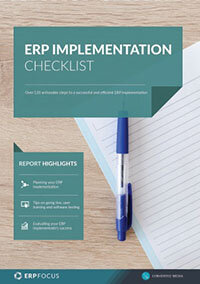3 Ways to Reduce ERP Workarounds During Implementation
1. Establish Consistent Processes
Effective ERP implementations are driven by consistency, and if one or more baseline processes are inconsistent, then the quality of resulting downstream information will be equally inconsistent. This means that, even though nearly every business will employ ERP workarounds to overcome perceived or real performance issues, it’s a very bad idea to work too far out of the box on a regular basis.
if one or more baseline processes are inconsistent, then the quality of resulting downstream information will be equally inconsistent
The ultimate impact of this process inconsistency is sometimes referred to as “data frangibility”, which occurs when the accumulation of ‘bad’ ERP data corrupts an entire record mass. If the situation is not dealt with quickly, this data corruption can ultimately choke a system’s performance down to a trickle.
The recovery from this kind of event on a large-scale ERP implementation is incredibly time consuming, and equally costly. In many cases, the only way to eliminate the ERP data logjam is to simply go back to the last solid set of backups. However, as one might expect this will cause a host of other problems since any data or resulting information will have to be re-introduced to the system beginning from its last stable status report.
Recommended Reading: ERP Implementation - 11 Steps to Success
The short answer to the consistency issue is to ‘just do what the book says’ from the outset of any ERP implementation and avoid creating an environment in which ERP workarounds can thrive. This suggestion will offer a relatively easy fix in the case of a fresh setup. However, with a balky existing system the only way to break bad habits is to re-train regularly, while repeatedly trimming the system toward optimal standards.
2. Establish Solid Training Habits
Establishing effective workforce training habits are akin to the Prince who has to kiss a frog in order to free a princess; he knows what he has to do, its just the puckering up that’s unpleasant. Nevertheless, solid training habits must become part of an enterprise’s operating fabric. Once people on the ERP management floor begin to push buttons on their respective keyboards, without adequate training, ERP workarounds will begin to spread.
A good, repeatable, training regime leading to a well educated workforce, will produce a return on the money and time invested over ensuing quarters and years, as it will support the crucial system consistency discussed above.
3. Measure Results Early and Often
While this suggestion may appear to be obvious, in many case businesses forget to follow this simple rule, and it can get managers in trouble in a heartbeat. As the old saying goes, “winning is a matter of keeping score”. Yet, in the midst of the daily push and pull of business, many ERP managers fail to clearly define *what system metrics they will measure and how often they will measure them.
This lack of system measurement leaves the business blind to any system inefficiencies which may encourage ERP workarounds, or, in fact, be caused by existing workarounds.
Free white paper

ERP Implementation: 9 steps to success
The 9 proven steps you should follow when implementing ERP

Featured white papers
-

ERP Implementation: 9 steps to success
The 9 proven steps you should follow when implementing ERP
Download -

ERP Implementation Checklist
Over 120 actionable steps to implementing a new ERP successfully
Download -

Manufacturing ERP Implementation Checklist
Over 70 actionable steps to rolling out new manufacturing ERP software
Download
Related articles
-

Top 10 causes of ERP implementation failure (and how to avoid it)
Few people in an organization ever understand how difficult an ERP implementation is, and how a f...
-

Secret KPI: Why Your ERP Implementation Team Matters More Than Software
Learn how Godlan ensures successful ERP implementation for manufacturers with proven strategies &...
-

The case for multi-tier ERP implementations
Learn more about multi-tier ERP implementation and why you might need one

